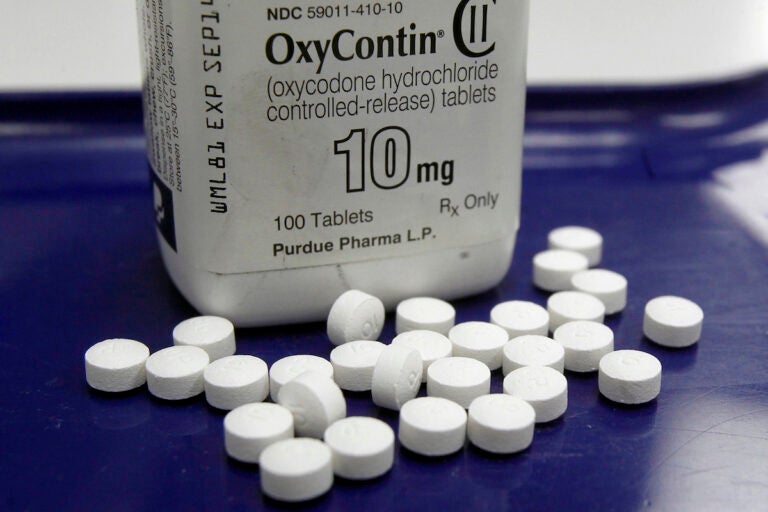How opioid prescriptions are tracked and monitored by law enforcement and health care providers
Medical sociologist Liz Chiarello discusses the effects of prescription drug monitoring programs on both patients and physicians.
Listen 12:22
This Feb. 19, 2013, file photo shows OxyContin pills arranged for a photo at a pharmacy in Montpelier, Vt. (AP Photo/Toby Talbot, File)
This story is from The Pulse, a weekly health and science podcast.
Find it on Apple Podcasts, Spotify, or wherever you get your podcasts.
Associate Professor of Sociology at Saint Louis University, Liz Chiarello, argues that new drug surveillance programs called Prescription Drug Monitoring Programs (PDMPs) blur the lines between law enforcement and health care.
In her recently published book, “Policing Patients: Treatment and Surveillance on the Frontlines of the Opioid Crisis,” Chiarello discusses instances of patients being denied care and doctors being prosecuted for overprescribing pain medications.
PDMPs were put in place as one solution in response to the growing number of opioid-related deaths in the United States.
A PDMP is a database that tracks prescriptions of controlled substances, like morphine or oxycodone. These programs were made to document and flag doctors who overprescribe opioids to patients and identify patients who visit several doctors to obtain new prescriptions. Law enforcement agents, prosecutors, physicians, and pharmacists all have access to this database and medical information. This brings up questions about privacy, says Chiarello, and whether or not access to this information goes against the privacy rights of the individual or the patient.
[The PDMP], “undermines the way that we usually think that medicine should work and the privacy protections that are associated with our health data,” says Chiarello.
PDMPs do not only affect patients. They flag physicians too.
“If doctors violate the stipulations under which they’re allowed to provide these controlled medications, then they’re extremely vulnerable because you go from being a doctor in the eyes of the law to being a drug dealer in the eyes of the law,” Chiarello says.
Physicians can face arrest, prosecution, and even jail time if law enforcement notices a pattern of overprescribing opioids to their patients.
So, what happens when a patient with suspicious opioid-use history goes to the pharmacy to request a new prescription?
Chiarello says a pharmacist might say, “Well, I looked you up in the database and the database shows me that you just went to two different doctors in the last month. And so, this is too soon for me to dispense this to you.”
Chiarello says this direct communication from the pharmacist, “says to the patient, I’m looking at you. And I have data about what you’ve been doing when you’re not at my pharmacy. But then it also tells them, you’re not really welcome back here. Like, don’t come back to me because I’m surveilling you.”
The goal of these programs is to deter people from overusing opioids, and therefore lessen the impact of the opioid crisis. However, people who use opioids, larger amounts that might be flagged by a PDMP, are not all opioid abusers. For example, there are patients with chronic pain who have been living with a certain prescription that allows them to function normally in their daily lives. Without it, they would be living in constant pain.
Chiarello dives deeper into the topic of PDMPs and how these programs impact patients with chronic pain and the future of drug prescription regulation in a conversation with Maiken Scott, host of The Pulse.
Interview Highlights:
Doctors’ response to PDMPs
Doctors have had to figure out how to rework their practice to navigate a shifting legal territory. And so what a lot of doctors have done is they just refused to provide opioids. And they feel like that protects them, but it doesn’t necessarily protect their patients. So this is a space where the ethics of medicine and the care for the patient bump up against the fear of law enforcement.
… [Doctors] have patients sign pain contracts, which are these legalistic documents that say things like, I am your only doctor, you’re only going to see me, you are only going to go to this one pharmacy. I’m going to test your urine when I want to. You’re not going to go to the hospital asking for opioids, and if you do any of those things, if you violate the stipulations of our contract, you are no longer my patient. I will cut you off.
Subscribe to The Pulse
What happens to patients who rely on opioid prescriptions to get through the day just because their chronic pain is so terrible?
It’s really devastating what’s happened to those patients. The biggest driver is the CDC guidelines on using opioids to treat pain that came out in 2016 … and they make a lot of suggestions about what dosage patients should be on, when to initiate a dose. And it’s really supposed to be for people who are newly on opioids. But by the time those came out, there were people who had been on opioids for 20 years, who were in chronic pain, who are on very high doses of opioids. And there was a lot of pressure to taper those people down. The measurement is … called a morphine milligram equivalent, an MME. And the CDC guidelines say that people should be under 90. And a lot of people are on 300 or 350. And so a lot of doctors are concerned that that creates a red flag for them to law enforcement. And so they then try to cut those patients down often very quickly and without consent. So you have patients who had been well managed on opioids, who suddenly are not well managed. And, they’re thrust into pain. And then they can’t find another doctor who’s willing to prescribe for them. And so those patients, those patients are really suffering.
Could you see the PDMPs being used in any other way? Could you see their use being expanded?
I have made the argument that the PDMP is a law enforcement surveillance tool. And that, even if it’s in health care, it retains the vestiges of being a law enforcement surveillance tool … And so, we have to rethink whether we think prescription data is private data, or if we think it’s something else, the way that it’s being treated right now.
But you also asked if I can see it expanding, and you know the saying… matter can be neither created nor destroyed. Well, technology is so easily created and very difficult to destroy. Because once you’ve created the technology, suddenly you realize there are all kinds of different uses for the technology. And so, one of the things that has changed with PDMPs is in a couple of states, they’ve started to put drug arrest data in the PDMP. So, they’re actually combining law enforcement data with health care data in the same system.
But we can also certainly imagine a lot of other drugs being policed. I’m thinking about drugs used for reproductive health. I’m thinking about drugs used for gender affirming care. Once you have this kind of system, it’s very easy to add other drugs and to track other kinds of drugs. And so, I think they’ve only just barely dipped their toes into what kinds of medications they’re going to surveil.
This interview has been edited for length and clarity.
WHYY is your source for fact-based, in-depth journalism and information. As a nonprofit organization, we rely on financial support from readers like you. Please give today.






